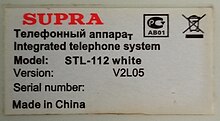Made in China


Made in ChinaorMade in PRCis acountry of originlabel, often in English, affixed to products wholly or partially made in thePeople's Republic of China(PRC). The label became prominent in the 1990s, when foreign companies based in the United States, Europe, and Asia moved theirmanufacturing operationsto China due to China's lowproduction costsof clothing, electronics, and other goods.[1]"Made in China" eventually became associated with cheap,exploitable labor,churning out numerousmass marketproducts of low quality.
Goods "made in China", however, have been produced throughsupply chainsthat usually included multiple countries along the way.[2]
History[edit]
The historical roots of "Made in China" date back to the early 1940s during the Second Sino-Japanese War when Chinese civilians boycotted Japanese-made products, reflecting a desire for domestic production and economic independence.
The label was first widely used during the Japanese occupation of China in theSecond Sino-Japanese War,when Chinese civilians began to boycott Japanese-made products. At the time,China's economylacked a framework for effectiveindustrialization.As such, boycotting foreign-made products and buying domestic ones at that time became a way to put pressure on the Japanese economy under the so-called "national salvation effort".[3]
By the early 21st century, goods labeled "Made in China" were often only partially made in China, such as US-designediPhone.[2]In 2015, China devised "Made in China 2025",the government's ten-year plan to update national manufacturing base by rapid development of localhigh-techindustry.[3]
The phrase "Made in China" is undergoing a transformation from its traditional associations with low quality to now encompassing advanced applications such as artificial intelligence and semiconductor technology.[4]
Quality and perception[edit]
According to long-term research published byEuropean Central Bankin 2011, the quality of Chinese products exported toEU marketsis high relative to other developing economies, even at low unit cost.[5]The study challenged the assumption that low-cost products from China are of low quality and suggested that the quality of Chinese products is similar to that of the most technologically advanced competitors and economies.[5]The study also indicated that Chinese products were an anomaly in the relationship between price and quality; while products from most countries became relatively expensive as the quality increased, Chinese products remained affordable despite the upgrading quality.[5]
According to aPew Research Centersurvey in November 2023, the quality of Chinese technology products is seen as generally well-made, but worse than American products. Respondents from few countries, such as Israel and India, held particular negative views toward Chinese products.[6]
See also[edit]
References[edit]
- ^David Barboza(8 February 2006)."'Made in China' labels don't tell whole story ".The New York Times.Retrieved18 January2024.
- ^abElizabeth O'Brien Ingleson (2024).Made in China: When US-China Interests Converged to Transform Global Trade.Harvard University Press. p. 266.ISBN978-0674251830.
- ^abAmy Wang (20 December 2018)."Made in China: Past and Present".Business Today.Retrieved18 January2024.
- ^James McBride and Andrew Chatzky (May 13, 2019)."Is 'Made in China 2025' a Threat to Global Trade?".Council on Foreign Relations.Retrieved3 July2024.
- ^abcPula, Gabor; Santabárbara, Daniel (March 2011)."Is China climbing up the quality ladder? Estimating cross country differences in product quality using Eurostat's COMEXT trade database"(PDF).ECB Working Papers(1310).European Central Bank:9–29.ISSN1725-2806.
- ^Silver, Laura (6 November 2023)."Comparing Views of the U.S. and China in 24 Countries".Pew Research Center.
